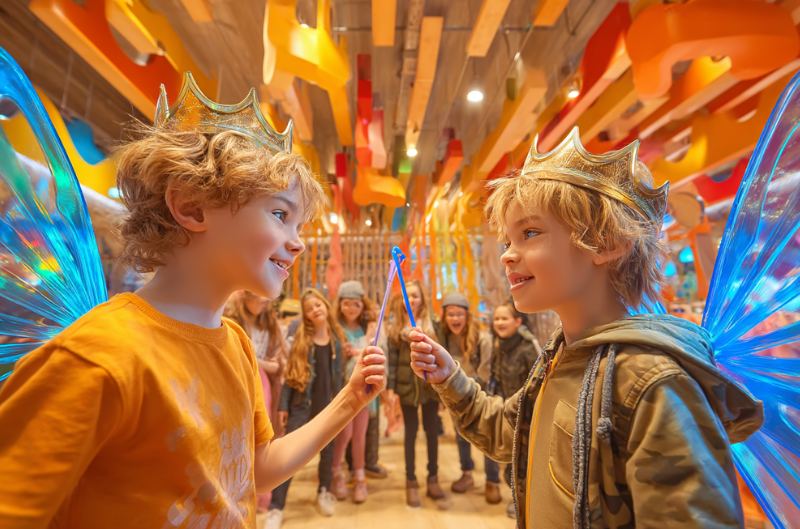
Play Through the Gender Lens: Challenging Stereotypes in Childhood Play
Author: Austin Stanfel
Childhood play is a vital arena where children explore, learn, and develop their identities, including their understanding of gender. However, play is often profoundly influenced by gender stereotypes- preconceived notions about what boys and girls “should” do, how they should behave, and what interests they should pursue. These stereotypes shape children’s play choices, peer interactions, development, and future opportunities. Challenging these stereotypes through play is essential for fostering healthier gender development, greater equality, and broader learning experiences for all children.
The Harmful Impact of Gender Stereotypes in Childhood Play
Gender stereotypes in childhood play are not merely harmless habits; they have significant consequences on mental health, self-esteem, and social development. Stereotypical play can contribute to poor mental health outcomes, including higher male suicide rates and low self-esteem among girls, by limiting children’s sense of self and reinforcing restrictive roles.
For example, boys may feel pressured to engage only in competitive, risky, or “masculine” play. At the same time, girls may be confined to nurturing or domestic roles, stunting their emotional and cognitive growth.
Moreover, gender-segregated play often leads to exclusionary practices where children control access to play areas based on gender norms, preventing cross-gender interaction and learning. This segregation reinforces rigid gender attitudes and biases that can persist into adulthood, affecting social relationships and occupational choices.
How Gender Stereotypes Manifest in Play
Children internalize what it means to be a boy or a girl from a young age, often mirroring societal and familial expectations. Studies have shown that children as young as 18 months display gender-typed toy preferences and play behaviors, which are shaped more by adult and cultural stereotypes than biological differences. For instance, girls dominate home corner and role-play areas, while boys prefer outdoor, construction, or computer play spaces.
Children’s pretend play reveals their understanding of gender play. “Having babies” or “being monsters” reflects what they perceive as appropriate for their gender. Sometimes, peers and adults unconsciously reinforce these behaviors through language, grouping, and play invitations. Even the composition of staff in early years settings can influence children’s perceptions; predominantly female staff may unintentionally reinforce traditional gender roles unless actively challenged.
The Role of Play in Gender Identity and Development
Play is a primary medium through which children learn and practice gender roles. Gender-typed play helps children develop skills and interests aligned with societal expectations. For example, boys engaging in construction play may develop spatial skills linked to male-typical occupations, while girls’ nurturing play may foster social and emotional skills. However, if children are confined to stereotypical roles, this can limit their exploration and self-concept.
Children’s gender identity and self-perceived gender typicality are closely tied to their play behaviors. Those who engage in gender-typed play tend to feel more aligned with their gender group, while those who do not may develop more flexible gender schemas. Encouraging diverse play experiences can thus support healthier, more inclusive gender development.
Strategies to Challenge Gender Stereotypes in Play
1. Creating Inclusive Play Environments
Early childhood settings and schools can actively challenge gender stereotypes by providing various toys, books, and activities that showcase diverse gender roles. For example, offering dolls and trucks to all children or presenting stories with men as caregivers and women in traditionally male roles helps broaden children’s perspectives.
Teachers and caregivers should avoid gender-segregated grouping or language, such as addressing children as “boys and girls,” and instead use inclusive terms like “friends” or “everyone.” This reduces the pressure on children to conform to gender binaries and fosters inclusivity.
2. Encouraging Cross-Gender Play and Friendships
Facilitating play that crosses traditional gender boundaries is crucial. Research shows that children who engage with peers holding counter-stereotypic toy preferences are more likely to desire diverse friendships and exhibit less rigid gender stereotypes.
Teachers can organize activities where boys and girls share roles, such as boys participating in crafts or girls in sports, and use drama or role-play to explore non-traditional gender roles.
3. Reflecting on Adult Attitudes and Practices
Adults’ own biases significantly influence children’s gendered play. Staff training should include awareness of gender issues and strategies to model non-stereotypical behavior. Mixed-gender staff teams can demonstrate cooperative work across gender lines, challenging traditional norms. Teachers should also examine their assumptions and language to avoid reinforcing stereotypes unconsciously.
4. Engaging Families and Communities
Since family and cultural contexts also shape children’s gender constructions, it is essential to engage parents and caregivers in conversations about gender diversity and inclusive play. Providing resources and examples of diverse gender roles can help families support their children’s exploration beyond stereotypes.
Benefits of Challenging Gender Stereotypes in Play
When children can explore a broad range of play activities without gender constraints, they gain access to a wider set of skills, interests, and social experiences. This inclusivity promotes:
- Enhanced cognitive and motor development by engaging in diverse play types.
- Improved social-emotional skills through varied peer interactions and empathetic role-play.
- Greater self-esteem and mental well-being can be achieved by allowing children to express their authentic selves.
- Expanded future occupational interests, especially for girls in STEM fields and boys in nurturing roles.
Conclusion
Challenging gender stereotypes in childhood play is a decisive step toward promoting equality, diversity, and healthy development. Play is not just a pastime but a formative experience where children learn about themselves and society. Creating inclusive environments, encouraging diverse play, reflecting on adult biases, and involving families, educators, and caregivers can help dismantle limiting gender norms.
This benefits individual children’s growth and well-being and contributes to a more equitable and empathetic society. This comprehensive approach to understanding and challenging gender stereotypes in childhood play draws on extensive research and practical strategies to foster a more inclusive and supportive environment for all children.

